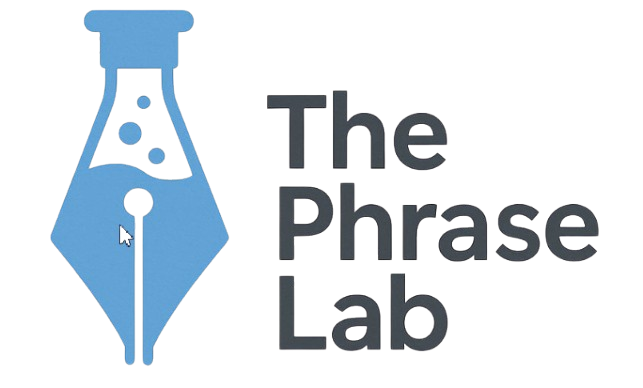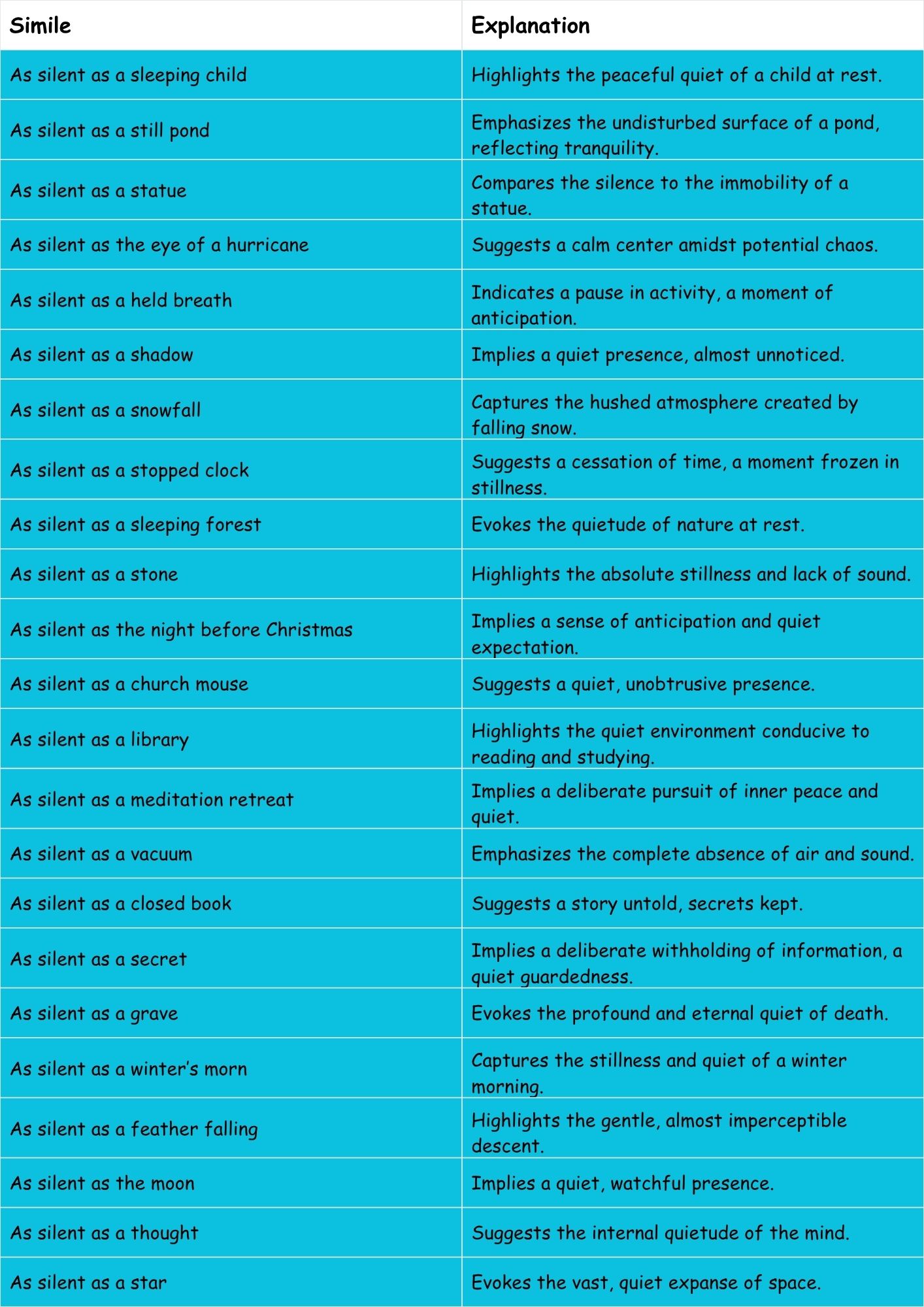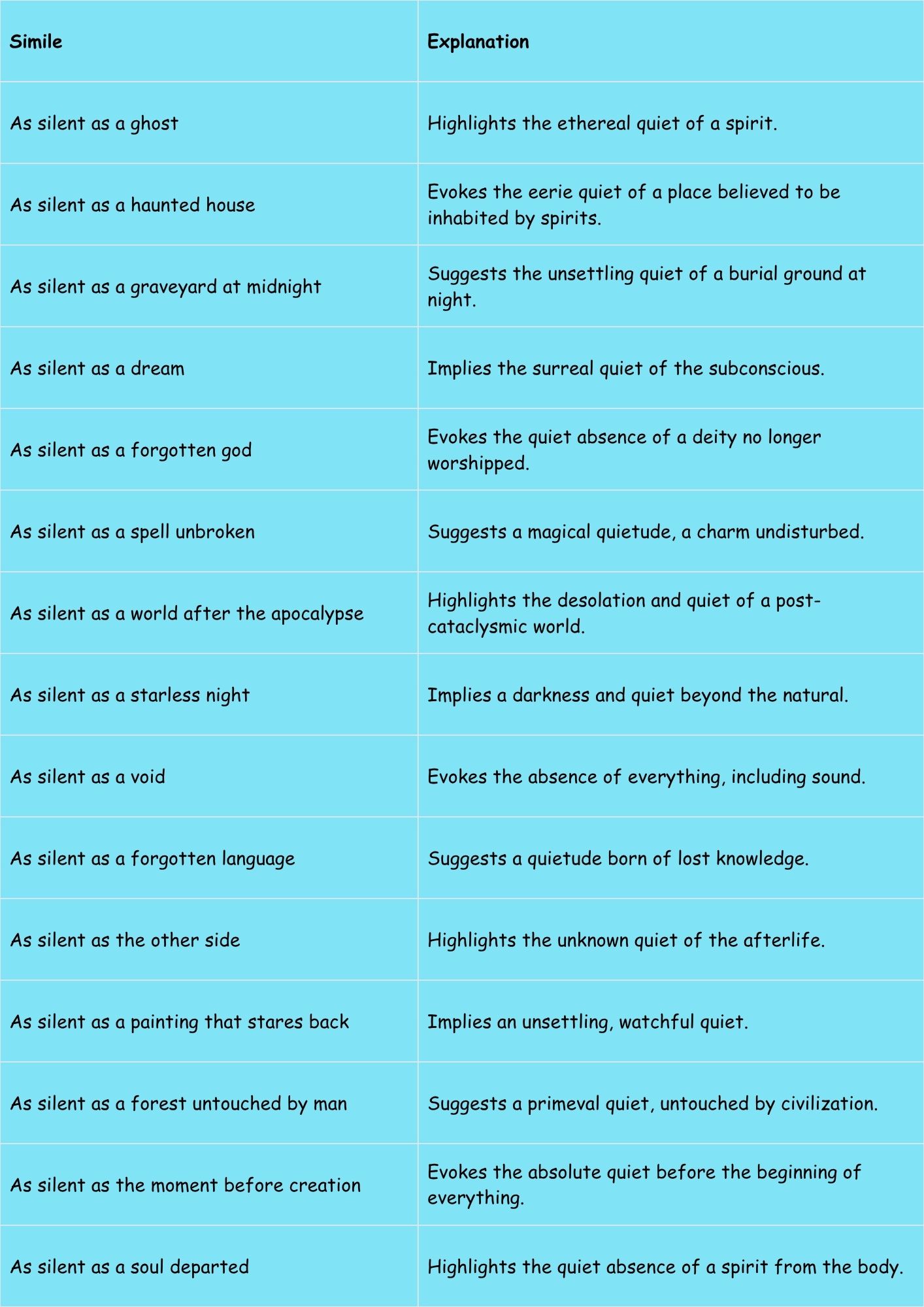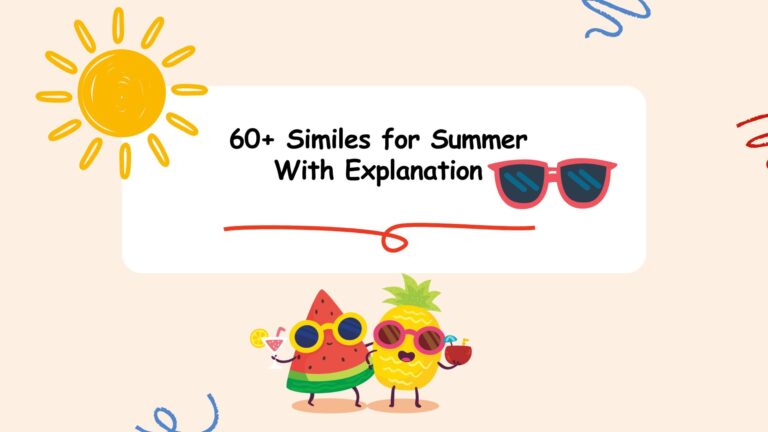
Similes for Silent: Mastering Figurative Language

Understanding similes is crucial for enhancing your writing and comprehension skills. Similes allow you to create vivid comparisons and paint clear pictures with words. This article focuses specifically on similes that describe silence, exploring various ways to convey the absence of sound through figurative language. Whether you are a student, writer, or language enthusiast, this guide will provide you with a comprehensive understanding of similes for “silent,” equipping you with the tools to express this concept with nuance and creativity.
This comprehensive guide will delve into the definition, structure, types, examples, usage rules, and common mistakes associated with using similes to describe silence. Through detailed explanations, numerous examples, and practice exercises, you will develop a strong understanding of how to effectively use similes to depict silence in your writing and speech. This knowledge will enable you to add depth, imagery, and impact to your communication.
Table of Contents
- Definition: Similes for Silent
- Structural Breakdown of Similes
- Types of Similes for Silent
- Examples of Similes for Silent
- Usage Rules for Similes
- Common Mistakes When Using Similes
- Practice Exercises
- Advanced Topics: Nuances in Simile Usage
- Frequently Asked Questions (FAQ)
- Conclusion
Definition: Similes for Silent
A simile is a figure of speech that compares two unlike things using the words “like” or “as.” Similes are used to create vivid imagery and enhance understanding by drawing parallels between familiar and unfamiliar concepts. When applied to the concept of “silent,” similes help to describe the absence of sound in a more evocative and imaginative way than simply stating “it was silent.”
In essence, a simile for “silent” aims to capture the essence of quietude by associating it with something else that is typically understood to be quiet or still. For example, saying something is “as silent as the grave” immediately conjures a sense of profound and unsettling quiet. The effectiveness of a simile lies in its ability to create a strong mental image and evoke a specific emotion or feeling associated with the silence being described.
The function of similes for silent is not merely descriptive; they also add layers of meaning and emotional resonance to writing. By carefully selecting the object or concept to which silence is compared, writers can subtly convey additional information about the nature of the silence – whether it is peaceful, eerie, expectant, or oppressive. The choice of simile can dramatically alter the reader’s perception of the scene or situation.
Structural Breakdown of Similes
The basic structure of a simile comprises three key components: the subject (what is being described), the linking word (“like” or “as”), and the object (what the subject is being compared to). Understanding this structure is fundamental to creating and interpreting similes effectively. Let’s break down each component:
- Subject: This is the entity, object, or situation that is being described as silent. It could be anything from a room to a person to an entire city.
- Linking Word: The words “like” or “as” serve as the bridge connecting the subject and the object of comparison. They explicitly indicate that a comparison is being made.
- Object: This is the entity, object, or situation that shares a quality with the subject, in this case, silence. The object is usually something that is commonly associated with quietness or stillness.
For example, in the simile “as silent as a mouse,” the subject is something unspecified that’s being described, “as” is the linking word, and “a mouse” is the object of comparison, known for its quiet movements. The effectiveness of the simile hinges on the reader’s understanding of the object’s inherent quality of silence.
The order of these components can sometimes be varied for stylistic effect, but the core structure remains the same. For instance, instead of saying “The night was as silent as a tomb,” one could say “As silent as a tomb, the night descended.” While the word order is different, the comparison between the night and the tomb remains clear.
Types of Similes for Silent
Similes for “silent” can be categorized based on the type of imagery they evoke and the specific qualities of silence they emphasize. Here are a few common types:
Similes Emphasizing Stillness
These similes compare silence to things that are inherently still or motionless. They often convey a sense of peace, tranquility, or anticipation.
Similes Emphasizing Emptiness
These similes compare silence to things that are empty or devoid of activity. They often convey a sense of loneliness, isolation, or desolation.
Similes Emphasizing Deceptive Silence
These similes compare silence to situations where quietness is misleading or hides something else. They often convey a sense of suspense, unease, or danger.
Similes Emphasizing Supernatural or Unnatural Silence
These similes compare silence to things beyond the realm of natural understanding. They often convey a sense of eeriness, the uncanny, or profound mystery.
Examples of Similes for Silent
Below are several examples of similes for “silent,” categorized for clarity. Each category provides a range of options to suit different contexts and desired effects.
Table 1: Similes Emphasizing Stillness
The following table presents similes that emphasize the stillness aspect of silence, evoking a sense of peace, tranquility, or anticipation.
| Simile | Explanation |
|---|---|
| As silent as a sleeping child | Highlights the peaceful quiet of a child at rest. |
| As silent as a still pond | Emphasizes the undisturbed surface of a pond, reflecting tranquility. |
| As silent as a statue | Compares the silence to the immobility of a statue. |
| As silent as the eye of a hurricane | Suggests a calm center amidst potential chaos. |
| As silent as a held breath | Indicates a pause in activity, a moment of anticipation. |
| As silent as a shadow | Implies a quiet presence, almost unnoticed. |
| As silent as a snowfall | Captures the hushed atmosphere created by falling snow. |
| As silent as a stopped clock | Suggests a cessation of time, a moment frozen in stillness. |
| As silent as a sleeping forest | Evokes the quietude of nature at rest. |
| As silent as a stone | Highlights the absolute stillness and lack of sound. |
| As silent as the night before Christmas | Implies a sense of anticipation and quiet expectation. |
| As silent as a church mouse | Suggests a quiet, unobtrusive presence. |
| As silent as a library | Highlights the quiet environment conducive to reading and studying. |
| As silent as a meditation retreat | Implies a deliberate pursuit of inner peace and quiet. |
| As silent as a vacuum | Emphasizes the complete absence of air and sound. |
| As silent as a closed book | Suggests a story untold, secrets kept. |
| As silent as a secret | Implies a deliberate withholding of information, a quiet guardedness. |
| As silent as a grave | Evokes the profound and eternal quiet of death. |
| As silent as a winter’s morn | Captures the stillness and quiet of a winter morning. |
| As silent as a feather falling | Highlights the gentle, almost imperceptible descent. |
| As silent as the moon | Implies a quiet, watchful presence. |
| As silent as a thought | Suggests the internal quietude of the mind. |
| As silent as a star | Evokes the vast, quiet expanse of space. |

Table 2: Similes Emphasizing Emptiness
The following table contains similes to highlight the feeling of emptiness associated with silence, often conveying loneliness, isolation, or desolation.
| Simile | Explanation |
|---|---|
| As silent as an empty room | Highlights the absence of activity or sound in a room. |
| As silent as a deserted street | Emphasizes the lack of people or traffic on a street. |
| As silent as a ghost town | Suggests a place abandoned and devoid of life. |
| As silent as the vacuum of space | Implies a complete absence of sound and atmosphere. |
| As silent as a forgotten memory | Evokes the fading of a memory into obscurity. |
| As silent as a broken promise | Suggests a betrayal or disappointment, a void left behind. |
| As silent as a hollow shell | Highlights the emptiness within a shell, devoid of its inhabitant. |
| As silent as a tomb | Emphasizes the profound and eternal quiet of death. |
| As silent as an abandoned house | Evokes a sense of neglect and forgotten history. |
| As silent as a dried-up well | Suggests a source of life that has run dry. |
| As silent as a canvas before a painting | Highlights the potential for creation, but currently empty. |
| As silent as a stage before the curtain rises | Suggests anticipation, but a current state of emptiness. |
| As silent as a mind without thoughts | Implies a blankness, a lack of mental activity. |
| As silent as a heart without love | Evokes a sense of emotional emptiness and longing. |
| As silent as a world without people | Highlights the desolation of a world devoid of human presence. |
| As silent as a locked diary | Suggests secrets and untold stories, hidden away. |
| As silent as a museum at night | Highlights the stillness and lack of visitors after hours. |
| As silent as an unplayed instrument | Evokes the potential for music, but currently dormant. |
| As silent as a darkened theater | Suggests the absence of a performance, a stage in waiting. |
| As silent as a mouth that cannot speak | Implies an inability to communicate, a forced quietude. |
Table 3: Similes Emphasizing Deceptive Silence
This table provides examples of similes that emphasize the deceptive nature of silence, suggesting that quietness can be misleading or hide something else. This often conveys suspense, unease, or danger.
| Simile | Explanation |
|---|---|
| As silent as a predator stalking its prey | Highlights the quiet approach of a hunter before an attack. |
| As silent as a bomb before it explodes | Suggests a dangerous calm before a destructive event. |
| As silent as a liar’s smile | Implies hidden deception behind a facade of quiet innocence. |
| As silent as a thief in the night | Evokes the stealthy movements of someone trying to avoid detection. |
| As silent as a sleeping volcano | Suggests a dormant threat that could erupt at any moment. |
| As silent as a coiled snake | Highlights the potential for sudden and dangerous action. |
| As silent as a trap waiting to be sprung | Implies a hidden danger ready to ensnare the unwary. |
| As silent as a secret kept hidden | Suggests a truth that is being deliberately concealed. |
| As silent as a conspiracy brewing | Evokes the clandestine nature of a plot being hatched. |
| As silent as a held secret | Highlights the tension of keeping something hidden. |
| As silent as a loaded gun | Implies a potential for violence, a hidden threat. |
| As silent as a hunter in camouflage | Suggests a deliberate attempt to blend in and remain unseen. |
| As silent as a spy on a mission | Evokes the stealth and covert nature of espionage. |
| As silent as a thought unexpressed | Highlights the potential for words that are never spoken. |
| As silent as a plot thickening | Suggests a gradual build-up of intrigue and suspense. |
| As silent as a predator in the jungle | Highlights the unseen danger lurking in the quiet. |
| As silent as a room before a storm | Suggests an impending disruption, a quiet before chaos. |
| As silent as a forest before a fire | Evokes a sense of impending destruction. |
| As silent as a chess player contemplating their move | Implies a deep strategy and quiet calculation. |
| As silent as a heart holding a grudge | Suggests a simmering resentment hidden beneath the surface. |
Table 4: Similes Emphasizing Supernatural or Unnatural Silence
This table introduces similes that emphasize silence by connecting it to supernatural or unnatural phenomena. These similes often convey a sense of eeriness, the uncanny, or profound mystery.
| Simile | Explanation |
|---|---|
| As silent as a ghost | Highlights the ethereal quiet of a spirit. |
| As silent as a haunted house | Evokes the eerie quiet of a place believed to be inhabited by spirits. |
| As silent as a graveyard at midnight | Suggests the unsettling quiet of a burial ground at night. |
| As silent as a dream | Implies the surreal quiet of the subconscious. |
| As silent as a forgotten god | Evokes the quiet absence of a deity no longer worshipped. |
| As silent as a spell unbroken | Suggests a magical quietude, a charm undisturbed. |
| As silent as a world after the apocalypse | Highlights the desolation and quiet of a post-cataclysmic world. |
| As silent as a starless night | Implies a darkness and quiet beyond the natural. |
| As silent as a void | Evokes the absence of everything, including sound. |
| As silent as a forgotten language | Suggests a quietude born of lost knowledge. |
| As silent as the other side | Highlights the unknown quiet of the afterlife. |
| As silent as a painting that stares back | Implies an unsettling, watchful quiet. |
| As silent as a forest untouched by man | Suggests a primeval quiet, untouched by civilization. |
| As silent as the moment before creation | Evokes the absolute quiet before the beginning of everything. |
| As silent as a soul departed | Highlights the quiet absence of a spirit from the body. |

Usage Rules for Similes
While similes are a powerful tool for enhancing description, it’s essential to use them correctly to avoid clichés or confusing comparisons. Here are some key usage rules:
- Ensure the Comparison is Clear: The object of comparison should be readily associated with the quality being described. If the connection is too obscure, the simile will fail to create the desired effect.
- Avoid Clichés: Overused similes (e.g., “as silent as the grave”) can lose their impact. Strive for originality and fresh comparisons.
- Maintain Consistency: Ensure that the simile aligns with the overall tone and style of your writing. A jarring or inappropriate simile can disrupt the flow and detract from the message.
- Consider the Audience: Tailor your similes to your audience’s knowledge and understanding. A simile that relies on specialized knowledge may not be effective for a general audience.
- Use Sparingly: While similes can be effective, overuse can make your writing feel contrived. Use them judiciously to highlight key moments or create particularly vivid imagery.
It’s also important to consider the context in which you’re using the simile. A simile that works well in one situation may be inappropriate in another. For example, a simile that emphasizes the peacefulness of silence might be suitable for describing a serene landscape, but not for describing a tense standoff.
Common Mistakes When Using Similes
Even experienced writers can make mistakes when using similes. Here are some common errors to avoid:
- Using Mixed Metaphors and Similes: Mixing metaphors and similes can create confusing and nonsensical images. For example, “The silence was like a blanket, drowning in a sea of quiet” combines a simile (“like a blanket”) with a metaphor (“drowning in a sea of quiet”) in a way that doesn’t make sense.
- Using Inaccurate Comparisons: Ensure that the comparison is logically sound. For example, saying “as silent as a roaring waterfall” is contradictory and ineffective.
- Overusing Similes: Too many similes can clutter your writing and make it feel forced. Use them sparingly and only when they add something meaningful to the description.
- Using Clichéd Similes: Clichés are overused and lack originality. Try to come up with fresh and unique comparisons.
Here’s a table illustrating some common mistakes and how to correct them:
| Incorrect Simile | Corrected Simile | Explanation |
|---|---|---|
| The silence was as loud as a mouse. | The silence was as complete as a vacuum. | The original simile is contradictory; silence cannot be loud. |
| As silent as the grave (cliché). | As silent as a forgotten tomb. | The corrected simile provides a fresh take on the concept of death. |
| The silence was like a blanket, then it punched me in the face. | The silence was like a heavy blanket, stifling all sound. | The original mixes unrelated images. |
Practice Exercises
Test your understanding of similes for “silent” with these practice exercises.
Exercise 1: Identifying Similes
Identify the similes in the following sentences:
- The room was as silent as a tomb.
- He moved as silent as a shadow through the house.
- The forest was like a sleeping giant, completely silent.
- The night was as silent as a winter’s morn.
- The old house stood as silent as a ghost.
- The water was as silent as a still pond.
- The library was as silent as a church.
- The secret was as silent as a grave.
- The anticipation was as silent as a held breath.
- The city was as silent as a ghost town.
Answer Key:
- as silent as a tomb
- as silent as a shadow
- like a sleeping giant, completely silent
- as silent as a winter’s morn
- as silent as a ghost
- as silent as a still pond
- as silent as a church
- as silent as a grave
- as silent as a held breath
- as silent as a ghost town
Exercise 2: Completing Similes
Complete the following similes with appropriate comparisons:
- As silent as __________.
- Like __________, the room fell silent.
- The night was as silent as __________.
- He stood as silent as __________.
- The forest was as silent as __________.
- The secret was as silent as __________.
- The house was as silent as __________.
- The street was as silent as __________.
- The church was as silent as __________.
- The town was as silent as __________.
Possible Answer Key:
- As silent as a sleeping child.
- Like a tomb, the room fell silent.
- The night was as silent as a grave.
- He stood as silent as a statue.
- The forest was as silent as a sleeping giant.
- The secret was as silent as a held breath.
- The house was as silent as a ghost.
- The street was as silent as a deserted road.
- The church was as silent as a library.
- The town was as silent as a ghost town.
Exercise 3: Creating Similes
Create your own similes for “silent” based on the following prompts:
- Describe the silence of a library.
- Describe the silence of a forest at night.
- Describe the silence of an empty room.
- Describe the silence of a graveyard.
- Describe the silence of space.
- Describe the silence of a secret.
- Describe the silence of a held breath.
- Describe the silence of a sleeping child.
- Describe the silence of an abandoned house.
- Describe the silence of a still pond.
Possible Answer Key:
- The library was as silent as a sanctuary.
- The forest at night was as silent as a sleeping beast.
- The empty room was as silent as a forgotten memory.
- The graveyard was as silent as a world beyond sound.
- Space was as silent as the absence of existence.
- The secret was as silent as a locked box.
- The held breath was as silent as a prayer unspoken.
- The sleeping child was as silent as an angel’s dream.
- The abandoned house was as silent as a lost soul.
- The still pond was as silent as a mirror to the sky.
Advanced Topics: Nuances in Simile Usage
For advanced learners, understanding the nuances of simile usage can elevate their writing to a higher level. This involves not only mastering the basic structure and avoiding common mistakes but also developing a keen sense of when and how to use similes to achieve specific effects.
Consider the emotional impact of different similes. For example, “as silent as a sleeping child” evokes a sense of peace and innocence, while “as silent as a tomb” evokes a sense of dread and finality. Choosing the right simile can significantly alter the reader’s emotional response.
Experiment with unconventional comparisons. While it’s important to ensure that the comparison is clear, don’t be afraid to think outside the box. A surprising or unexpected simile can be particularly effective in capturing the reader’s attention and creating a lasting impression. However, be cautious to not become too abstract otherwise the clarity of the simile’s meaning will be lost.
Pay attention to the rhythm and sound of your similes. The words you choose and the way you arrange them can affect the overall flow and cadence of your writing. A well-crafted simile should not only convey meaning but also sound pleasing to the ear.
Frequently Asked Questions (FAQ)
- What is the difference between a simile and a metaphor?
A simile compares two things using “like” or “as,” while a metaphor states that one thing *is* another. For example, “The silence was *like* a blanket” (simile) versus “The silence *was* a blanket” (metaphor). - Why are similes useful in writing?
Similes enhance descriptions, create vivid imagery, and add depth to writing by drawing comparisons that help readers understand and visualize concepts more effectively. - How can I avoid using clichés in my similes?
Think creatively and try to come up with original comparisons that are specific to the context you are writing about. Brainstorm different possibilities before settling on the first one that comes to mind. - Can I use similes in formal writing?
Yes, but use them sparingly and ensure they are appropriate for the tone and audience of your writing. Overuse can make your writing seem informal or contrived. - How do I choose the right object of comparison for a simile?
Choose an object that shares a clear and relevant quality with the subject you are describing. Consider the emotional impact and the overall message you want to convey. - What if my simile doesn’t make sense to the reader?
Re-evaluate the comparison and ensure that the connection between the subject and the object is clear and logical. If necessary, revise the simile or choose a different one. - Is it okay to use multiple similes in one paragraph?
It’s generally best to avoid using too many similes in close proximity, as it can make your writing feel cluttered. Use them judiciously and only when they add something meaningful to the description. - How can I improve my ability to create effective similes?
Practice writing similes regularly, read widely to observe how other writers use them, and seek feedback on your writing from others. The more you practice, the better you will become at crafting compelling and original similes.
Conclusion
Mastering the art of using similes for “silent” can significantly enhance your writing and communication skills. By understanding the structure, types, and usage rules of similes, you can craft vivid descriptions that capture the essence of silence in a compelling way. Remember to avoid clichés, maintain consistency, and consider your audience when choosing your comparisons.
Through practice and experimentation, you can develop a keen sense of when and how to use similes to achieve specific effects, adding depth, imagery, and emotional resonance to your writing. Continue to explore different possibilities and seek feedback on your work to refine your skills and elevate your writing to a higher level. With dedication and attention to detail, you can harness the power of similes to create truly memorable and impactful prose.



